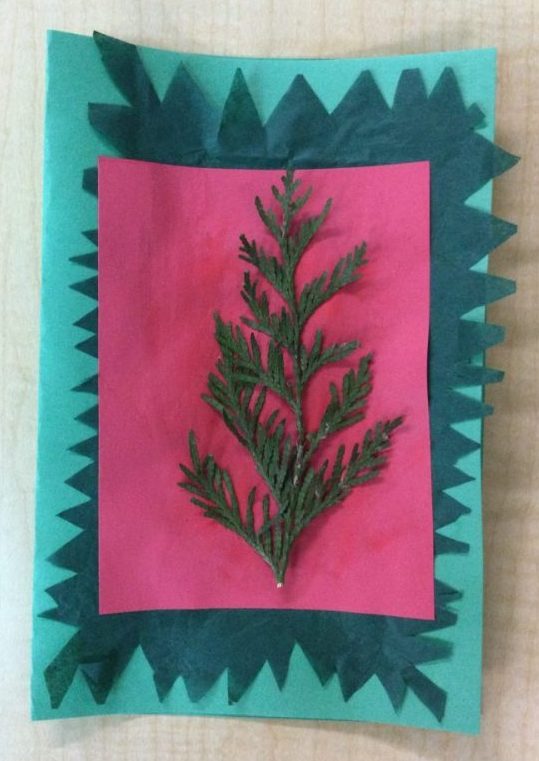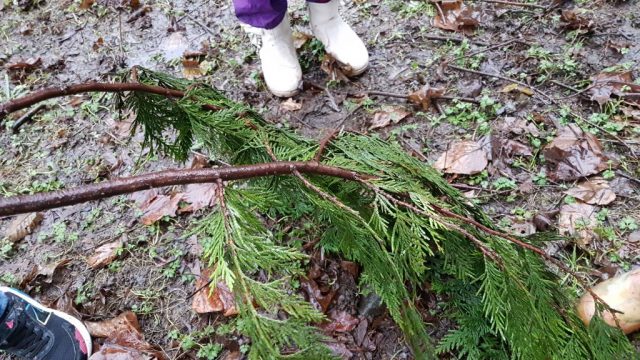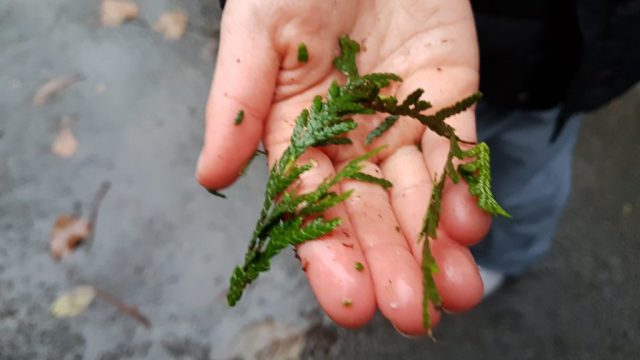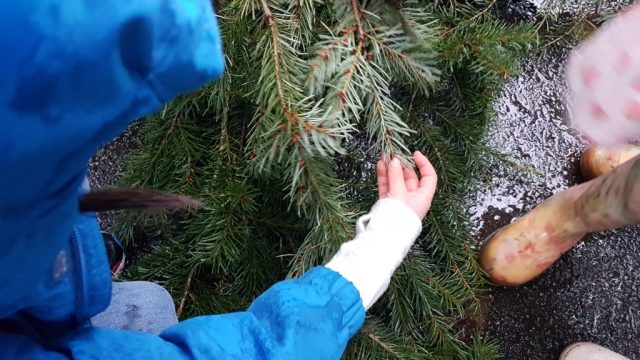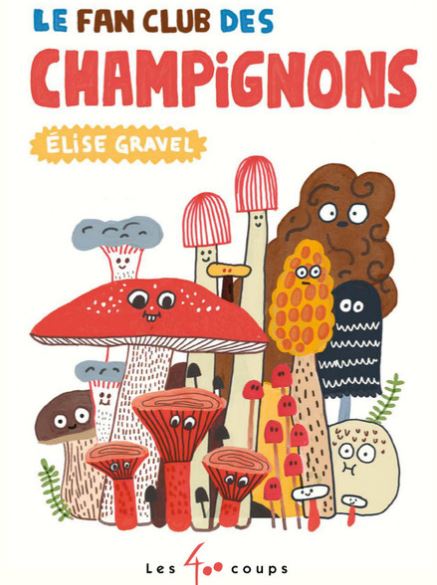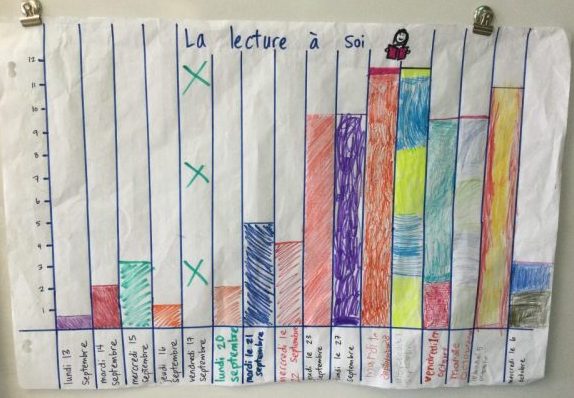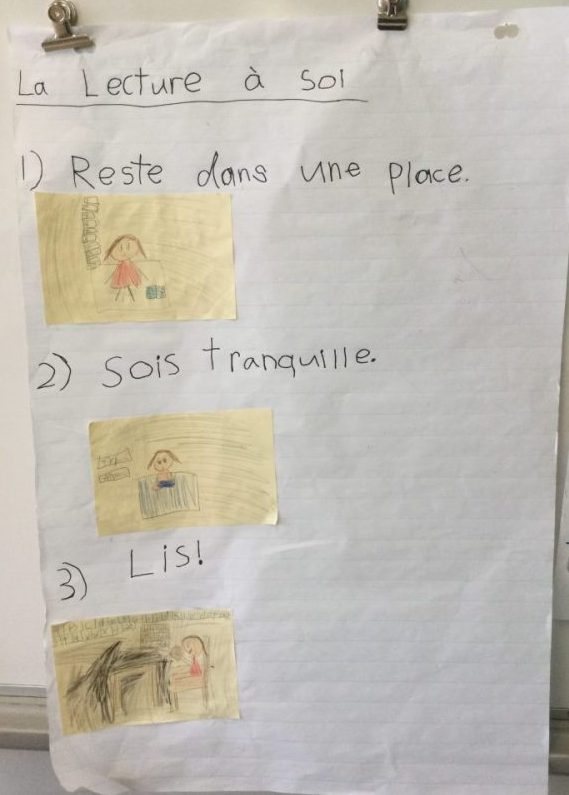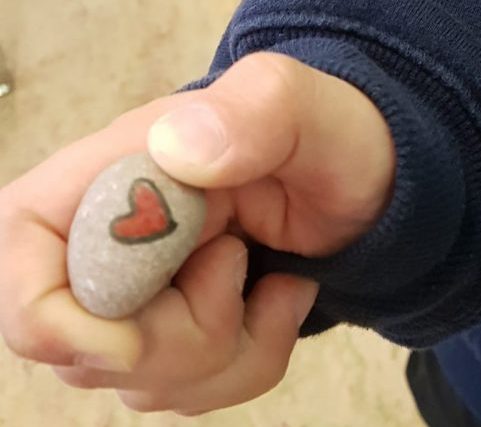Les cèdres
We’re learning that cedar was and continues to be an important tree for local Indigenous peoples.
We noticed there are many cedar trees near our school. On this nature walk, we focused on the branches, noting its flat needles and drooping shape.
When students rubbed its needles, they noted how good cedar smelled!
Some students found a branch from a neighbouring evergreen tree. We observed that the needles were different. They seemed sharper and bushier but were also flat. Its colour was a lighter green.
Beau, pas beau
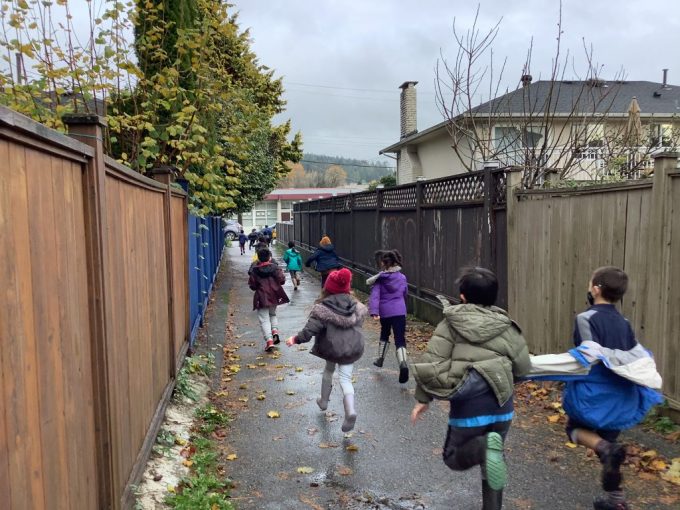 We continue to explore Dr. Gillian Judson’s walking curriculum. On this nature outing, students were asked to look for ‘beautiful’ and ‘not beautiful’ elements around our school.
We continue to explore Dr. Gillian Judson’s walking curriculum. On this nature outing, students were asked to look for ‘beautiful’ and ‘not beautiful’ elements around our school.
Rocks, lichen, and flowers were beautiful to most students; litter wasn’t beautiful. Mushrooms, specifically decaying mushrooms, drew a mixed reaction. Est-ce que c’est beau ou pas beau?
What about invasive species? Can they be beautiful? One student pointed out an invasive ivy plant. He considered it ‘pas beau’ for its damaging effect on our local ecosystem.
We next want to examine our findings and question how all things spotted on our walk may help our environment. Of course, it’s possible that not all of them can!
Ce qui est beau:
Ce qui n’est pas beau:
Les champignons
Voici quelques champignons observés derrière notre école. Here are some mushrooms observed behind our school.
As always, we practiced our personal and social responsibility by not touching wild mushrooms, especially toxic ones like the red-capped Fly Agaric (Amanita muscaria).
We’re learning more about fungi and their role in our local ecosystem. To help us, we’re reading Elise Gravel’s Le fan club des champignons.
Quel est l’intrus? – Version champignon
Math routines are an important part of our math program. One such routine is called “Which One Doesn’t Belong?” or WODB in English. In class, we’ve translated it to Quel est l’intrus?
Students must identify and explain which image doesn’t belong. There may be a few possible answers. Rather than it be about finding the ‘right’ answer, the focus is on explaining why their answer makes sense to them.
In math, we’re learning that we need to be precise and logical with our ideas. Students practice a few core competencies in this activity – communication, critical thinking, and creative thinking.
Recently, on a hike, I spotted four different mushrooms. Together, we discussed which one didn’t belong.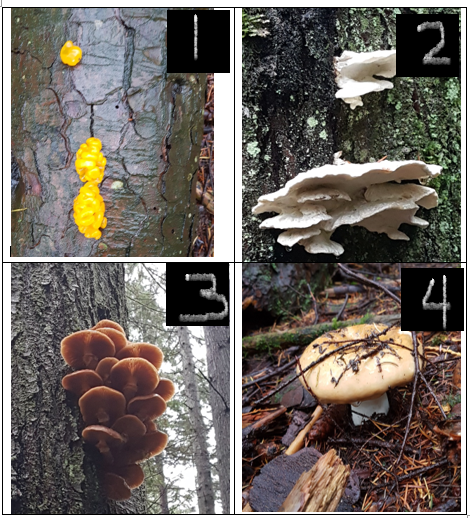 One student reasoned that Mushroom #1 didn’t belong because it was more narrow than the others. Another said that Mushroom #4 didn’t belong because it was the only one growing on the ground rather than on trees. Someone else added that Mushroom #4 was the only one that grew alone rather than in clusters.
One student reasoned that Mushroom #1 didn’t belong because it was more narrow than the others. Another said that Mushroom #4 didn’t belong because it was the only one growing on the ground rather than on trees. Someone else added that Mushroom #4 was the only one that grew alone rather than in clusters.
This math routine had us talk about form, size, colour, quantity, and orientation. Not only were we thinking like mathematicians but also like scientists!
We were curious to identify these local fungi. With the help of books and the Internet, we think:
- Mushroom #1 might be “Yellow Brain Jelly” or “Witches’ Butter”
- Mushroom #2 might be Oyster Mushrooms or Angel Wing Mushrooms
- Mushroom #3 might be ???
- Mushroom #4 looks like a Bolete – students found a picture of a “Weeping Bolete” and thought it had similar colours but that fungi seems more common in Europe
Finally, we talked safety. We understood to never touch or eat wild mushrooms. There are too many lookalike mushrooms, and it’s often tricky to tell apart poisonous ones from non-poisonous ones.
Students understood that it’s always best to simply observe a mushroom. In doing so, we respect their place in our local ecosystems and leave them be.
L’automne
On today’s nature walk, we looked for signs of fall. We noticed the usual changing of leaf colours, but we also noticed other clues. You can find them in the slideshow below.
La lecture à soi
Division 10 students have been practicing their reading stamina since our first full week together. We decided what three rules were most important when we read to ourselves.
Overall, students have been increasing their endurance. We debrief every day’s session and self-assess how we did. Did we stay in one spot? Were we calm and focused? Did we read?
We refer to the chart to analyze data and see if we can notice trends. A bit of math gets thrown into our literacy routine! Below, you can see our first completed chart as well as our three golden rules.
Les voisins animaux
Inspired by SFU professor and outdoor educator Gillian Judson’s Walking Curriculum, we set out for a nature walk. We decided to focus on locating animal neighbours. Students looked for traces of animal presence, like webs or nests. We were able to find four insects and arachnids just outside our classroom.
We found une coccinelle (ladybug), une abeille (a bee), and three types of araignée (spider). In a surprise twist, we witnessed an epic battle waged between two of the spiders!
Of the three spider species, we identified a Zebra Jumping Spider and an Orb Weaver. The third type was unidentified and trapped by the Orb Weaver. A few days later, students noticed that the Orb Weaver had trapped a wasp!
La réconciliation
Chaque enfant compte.
Division 10 participated in a school-wide reconciliation activity this week. Called the “Reconciliation Rock Project”, students first listened to older peers read Trudy’s Rock Story by Gitxsan author Trudy Spiller.
Then, students searched for their own special rock on a nature walk.
Once found, they added words and/or drawings to their rocks that show solidarity with and care for Indigenous peoples of Canada.
Their next step is to explain their rock’s significance to loved ones and return it to the environment. Hopefully, members of the local community will notice and appreciate them.
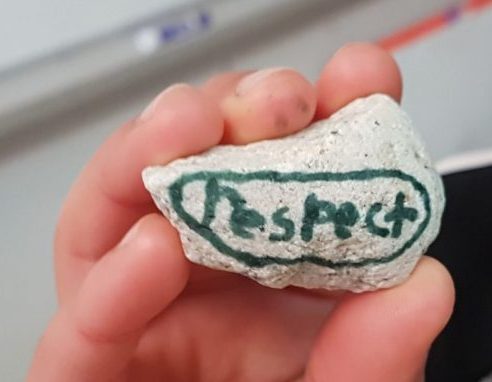 (In keeping with our belief to do no harm to nature, we used Crayola washable markers. Hopefully, these messages will be seen before the next rainfall!)
(In keeping with our belief to do no harm to nature, we used Crayola washable markers. Hopefully, these messages will be seen before the next rainfall!)
Il pleut!
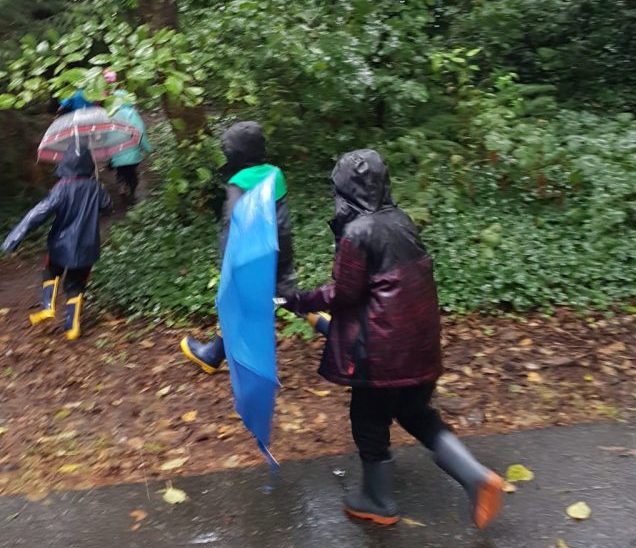 At the end of our first full week together, we ventured out into a rain storm for our first sortie nature. What a way to start our place-based education program with a bang – or, rather, splash! We’re building our stamina. On this very wet and blustery day, we understood that rain gear will be essential to exploring the outdoors comfortably this fall and winter.
At the end of our first full week together, we ventured out into a rain storm for our first sortie nature. What a way to start our place-based education program with a bang – or, rather, splash! We’re building our stamina. On this very wet and blustery day, we understood that rain gear will be essential to exploring the outdoors comfortably this fall and winter.
On this first outing, we discussed some basic rules: stay close to the group, stay focused on any tasks for the day, and do no harm to nature! Division 10 students had fun running in and out of the forest. They even found a ‘living’ tunnel shaped from brush and low-lying branches. We ended this first exploration by connecting to one of our 5 senses. We practiced listening attentively to rainfall on leaves overhead.

